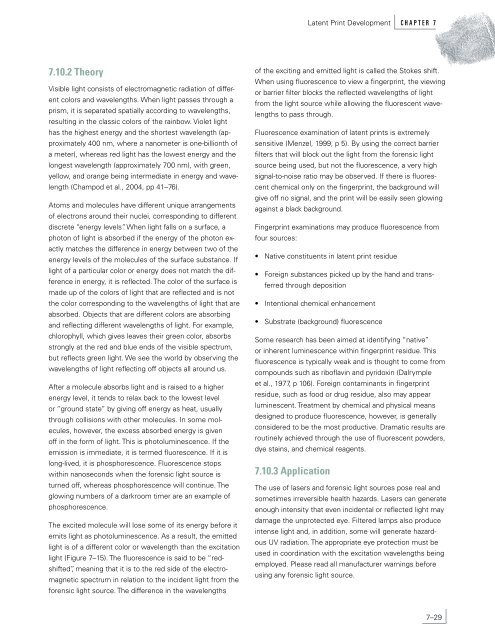Latent Print Development - National Criminal Justice Reference ...
Latent Print Development - National Criminal Justice Reference ...
Latent Print Development - National Criminal Justice Reference ...
Create successful ePaper yourself
Turn your PDF publications into a flip-book with our unique Google optimized e-Paper software.
7.10.2 Theory<br />
Visible light consists of electromagnetic radiation of differ-<br />
ent colors and wavelengths. When light passes through a<br />
prism, it is separated spatially according to wavelengths,<br />
resulting in the classic colors of the rainbow. Violet light<br />
has the highest energy and the shortest wavelength (ap-<br />
proximately 400 nm, where a nanometer is one-billionth of<br />
a meter), whereas red light has the lowest energy and the<br />
longest wavelength (approximately 700 nm), with green,<br />
yellow, and orange being intermediate in energy and wave-<br />
length (Champod et al., 2004, pp 41–76).<br />
Atoms and molecules have different unique arrangements<br />
of electrons around their nuclei, corresponding to different<br />
discrete “energy levels”. When light falls on a surface, a<br />
photon of light is absorbed if the energy of the photon ex-<br />
actly matches the difference in energy between two of the<br />
energy levels of the molecules of the surface substance. If<br />
light of a particular color or energy does not match the dif-<br />
ference in energy, it is reflected. The color of the surface is<br />
made up of the colors of light that are reflected and is not<br />
the color corresponding to the wavelengths of light that are<br />
absorbed. Objects that are different colors are absorbing<br />
and reflecting different wavelengths of light. For example,<br />
chlorophyll, which gives leaves their green color, absorbs<br />
strongly at the red and blue ends of the visible spectrum,<br />
but reflects green light. We see the world by observing the<br />
wavelengths of light reflecting off objects all around us.<br />
After a molecule absorbs light and is raised to a higher<br />
energy level, it tends to relax back to the lowest level<br />
or “ground state” by giving off energy as heat, usually<br />
through collisions with other molecules. In some mol-<br />
ecules, however, the excess absorbed energy is given<br />
off in the form of light. This is photoluminescence. If the<br />
emission is immediate, it is termed fluorescence. If it is<br />
long-lived, it is phosphorescence. Fluorescence stops<br />
within nanoseconds when the forensic light source is<br />
turned off, whereas phosphorescence will continue. The<br />
glowing numbers of a darkroom timer are an example of<br />
phosphorescence.<br />
The excited molecule will lose some of its energy before it<br />
emits light as photoluminescence. As a result, the emitted<br />
light is of a different color or wavelength than the excitation<br />
light (Figure 7–15). The fluorescence is said to be “red-<br />
shifted”, meaning that it is to the red side of the electro-<br />
magnetic spectrum in relation to the incident light from the<br />
forensic light source. The difference in the wavelengths<br />
of the exciting and emitted light is called the Stokes shift.<br />
When using fluorescence to view a fingerprint, the viewing<br />
or barrier filter blocks the reflected wavelengths of light<br />
from the light source while allowing the fluorescent wave-<br />
lengths to pass through.<br />
Fluorescence examination of latent prints is extremely<br />
sensitive (Menzel, 1999, p 5). By using the correct barrier<br />
filters that will block out the light from the forensic light<br />
source being used, but not the fluorescence, a very high<br />
signal-to-noise ratio may be observed. If there is fluores-<br />
cent chemical only on the fingerprint, the background will<br />
give off no signal, and the print will be easily seen glowing<br />
against a black background.<br />
Fingerprint examinations may produce fluorescence from<br />
four sources:<br />
• Native constituents in latent print residue<br />
• Foreign substances picked up by the hand and trans-<br />
ferred through deposition<br />
• Intentional chemical enhancement<br />
• Substrate (background) fluorescence<br />
Some research has been aimed at identifying “native”<br />
or inherent luminescence within fingerprint residue. This<br />
fluorescence is typically weak and is thought to come from<br />
compounds such as riboflavin and pyridoxin (Dalrymple<br />
et al., 1977, p 106). Foreign contaminants in fingerprint<br />
residue, such as food or drug residue, also may appear<br />
luminescent. Treatment by chemical and physical means<br />
designed to produce fluorescence, however, is generally<br />
considered to be the most productive. Dramatic results are<br />
routinely achieved through the use of fluorescent powders,<br />
dye stains, and chemical reagents.<br />
7.10.3 Application<br />
The use of lasers and forensic light sources pose real and<br />
sometimes irreversible health hazards. Lasers can generate<br />
enough intensity that even incidental or reflected light may<br />
damage the unprotected eye. Filtered lamps also produce<br />
intense light and, in addition, some will generate hazard-<br />
ous UV radiation. The appropriate eye protection must be<br />
used in coordination with the excitation wavelengths being<br />
employed. Please read all manufacturer warnings before<br />
using any forensic light source.<br />
<strong>Latent</strong> <strong>Print</strong> <strong>Development</strong> C H A P T E R 7<br />
7–29

















